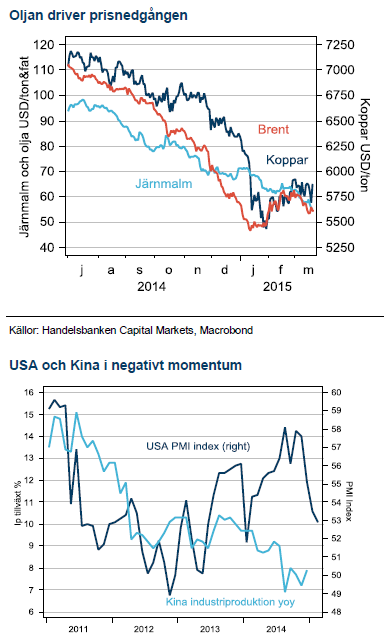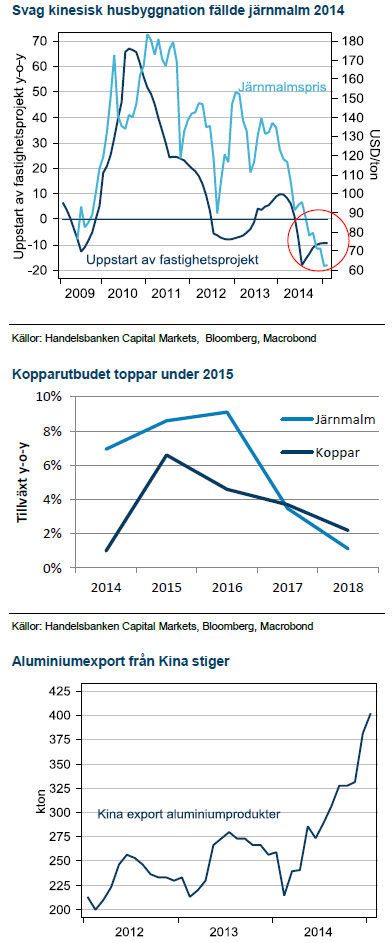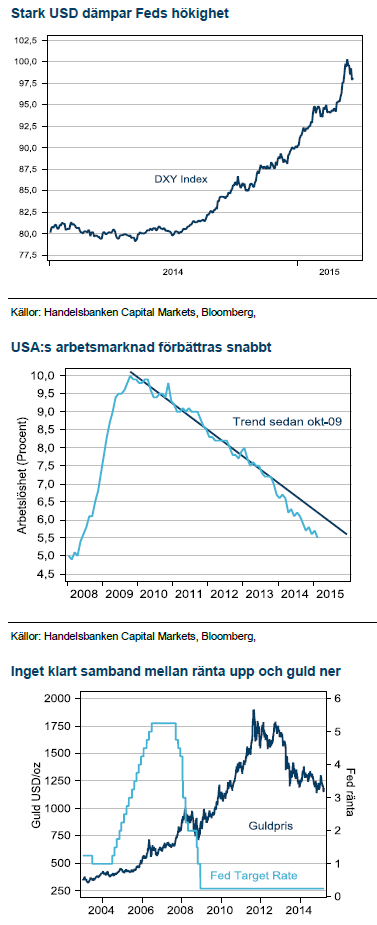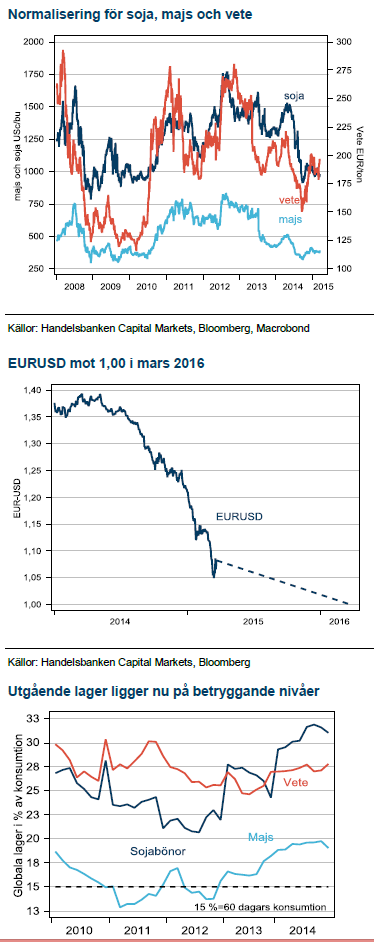Analys
Råvaruplanket – Lägre priser driver lägre priser

Februari månads kraftiga uppgång på 25% i oljepriset fick ett abrupt slut i mars när marknadens fokus återvände till underliggande fundamenta som i våra ögon inte förbättrats trots att snart nio månader passerat sedan oljeraset startade i juli 2014. Olja är inte bara centralt för världsekonomin, det är också den råvara med störst inflytande på produktionskostnaden för andra råvaror. Det är därför svårt att se stora prisuppgångar i metaller eller elpriser när de lägre oljepriserna fortsätter att äta sig in i produktionskostnaden för råvaror.
Kinas makrodata är inne i en svår period med nyårsledigheten som störande moment. Fastighetspriserna visade dock rekordfall i februari och de är just nu drivkraften nummer ett, via mindre nybyggnation, till lägre priser på basmetaller.
…och USA sänker ädelmetallerna
Förra veckans besked från Fed var oväntat mjukt. Det fick guld att handlas upp med 2 %. Det visar att guldets känslighet för Feds kommande höjning finns kvar och Feds anträdande av höjningscykeln kommer pressa guldpriset som bubblat under sju års expansiv penningpolitik.
Vete stiger med USD
En stark USD minskar efterfrågan på amerikanskt vete. Istället vänder sig köparna till Europa och det har drivit upp vete i Paris under mars. Goda förutsättningar för en ny bra global skörd får oss dock att tro på lägre priser.
Basmetaller
Våra förhoppningar på stigande nickelpriser under 2015 var höga. För höga. Under vår resa till Indonesien framkom att Kina inte lider av Indonesiens exportförbud på nickelmalm såsom marknaden förväntat sig. Bristen på Indonesisk malm har i stor utsträckning kompenserats av ökad export från Filipinerna. Kinas efterfrågan på rostfritt stål har också fallit och i en sådan marknad räcker inte Indonesiens exportförbud till för att driva priset.
Koppar från 6000 till USD 5000
Vi har länge haft tron att kopparpriset ska falla. Utbudsvågen som var aviserad till 2014 har i stor utsträckning flyttats fram till 2015. Ett välbekant tema i kopparindustrin är utbudsstörningar. Även i år har dessa gjort sig påminda och senast är det världens näst största koppargruva, Grasberg som strängt produktionen efter blockad av gruvarbetare. Utbudsstörningarna i koppar är en av faktorerna som gör att koppar inte strukturellt går att likna vid järnmalm och därför tro vi inte att nedgången blir lika dramatisk. Lägre efterfrågan i Kina parat med högre tillväxt i gruvproduktionen är dock fortfarande en missmatch som vi tror får ner priset till 5500 USD/ton under första halvåret och handel ner till USD 5000 under andra halvåret.
Aluminium fallit ur sin kanal
Kina har under en flerårig process skapat överkapacitet när nya aluminiumsmältverk etablerats när kolfälten i de västra provinserna samtidigt som de gamla, kustnära inte stängts ned i den omfattning man tänkt sig. Kina har en lång tradition av svårighet att få bukt med överkapacitet då ledarna värnar om arbetsmarknaden under stundande inbromsning i tillväxten. Export av aluminium är belagd med en skatt men export av bearbetade aluminiumkomponenter stiger nu kraftigt och pressar priserna i Väst. Marknadsbalansen i Väst brukar anses vara i balans men kommer fortsätta pressas av kinesisk export i våra ögon.
Energi
Opec ska inte sänka
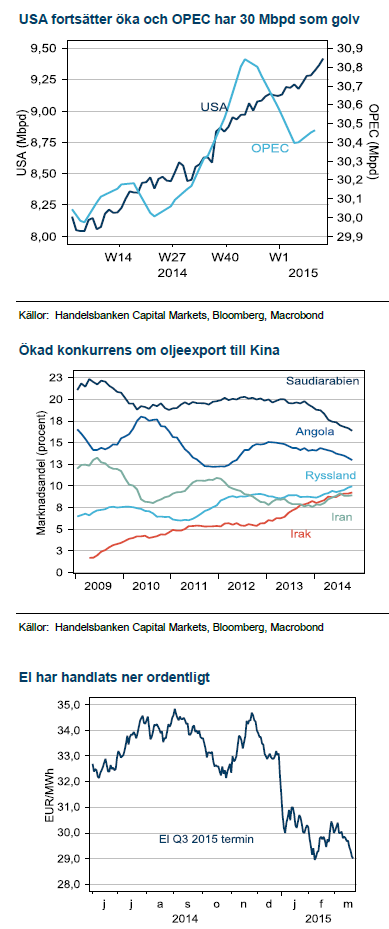 Med drygt två månader kvar till OPEC:s möte den 5:e juni i Wien har det åter börjat byggas upp förhoppningar om att kartellen ska strama upp marknaden och reglera överproduktionen som pressat priset. Vi sätter ingen tilltro till de förhoppningarna. Om OPEC skulle minska produktionen nu har hela prisnedgången varit för gäves och USA skifferproducenter kommer åter öka produktionen i samma takt som förut.
Med drygt två månader kvar till OPEC:s möte den 5:e juni i Wien har det åter börjat byggas upp förhoppningar om att kartellen ska strama upp marknaden och reglera överproduktionen som pressat priset. Vi sätter ingen tilltro till de förhoppningarna. Om OPEC skulle minska produktionen nu har hela prisnedgången varit för gäves och USA skifferproducenter kommer åter öka produktionen i samma takt som förut.
Riggräkning inte central
Marknaden har haft ett starkt fokus på rekordfallet i antalet aktiva borriggar i USA under februari. Ett flertal mekanismer gör att antalet borrade hål inte är proportionell mot oljeproduktionen i skifferfälten i det kortare perspektivet. Kostnadsfokus bland producenterna pågår i storleksordningen 30-50% under 2015 och ökar livskraften i Amerikanska skifferfält.
Iranfrågan på bordet
USA har indikerat att häv av sanktionerna mot Irans export av olja kan vara nära förestående. Förhandlingarna med Iran som hålls i Genève har en deadline i slutet av mars, ännu kvarstår flera viktiga detaljer enligt talesmän men USA:s uttalande har väkt förhoppningar som fått oljepriset på nytt fall. Iran har sagt sig kunna växla upp sin export mer eller mindre omedelbart, även om vi tror att USA kommer häva sanktionerna successivt för att behålla kontrollmedel över Irans kärnvapenaktivitet och inte dra undan mattan för skifferproducenterna. Kommer Iran tillbaka med 1 miljon fat per dag i export neutraliseras hela den förväntade nedgången i tillväxt i USA:s skifferfält. I det scenariot ser vi Brent omkring USD 40, men sannolikheten är lägre än 30%. Iranframsteg har följts av bakslag enligt historien.
Nedgång på elmarknaden
Vår syn är fortsatt negativ på elprisutvecklingen kommande halvår. Förra veckan rullade SHB elcertifikat till Q3 terminen som underliggande, där vi ser en nedsida på 2 EUR från dagens 24,4 EUR förutsatt att inte nuvarande vädertrender bryts fram till SHB rullar ur Q3 och in i Q4 under första veckan i juni. God tillrinning i vattenmagasinen från gynnsamma snölägen är en faktor som sänker prisbilden. Jämförelser med fjolårets prisnivå är förvirrande eftersom fjolåret hade en extremt varm och torr sommar som gav låg vindkraftsproduktion och dålig tillrinning samtidigt som Tyskland export av solkraft var låg med mycket ruskväder.
Ädelmetaller
Vi har tidigare haft för högt ställda förväntningar på hur snart Fed ska genomföra sin första räntehöjning. Efter senaste beskedet från Fed den 18:e mars signalerades en långsammare räntehöjning efter att framförallt USD har stärkts markant. Guld steg 2 % på Feds avvaktande tonläge och den stora prisrörelsen visar att det fortfarande finns mycket prispåverkan kvar i guld beroende på hur Fed agerar. I dagsläget prisas en räntehöjning in fullt ut i september av räntemarknaden.
Feds supermjuka penningpolitik var den främsta drivkraften till guldprisuppgången efter finanskrisen. När Fed nu ska börja på åtstramningscykeln kommer det ha negativ inverkan på guldpriset. En stor del av nedgången har sannolikt redan kommit när Fed först började prata om åtstramning under 2013. Med Feds svåranalyserade start av räntehöjningscykeln är det dock rimligt att mer finns kvar.
Silver årets vinnare
Silver har oväntat dykt upp som årets bästa råvara, upp 6 % efter ett rally på 17% efter att Schweiz centralbank beslutade att överge golvet för växelkursen mot EUR samtidigt som Grexit oron eskalerade. Februari månads starka USA data och en allt starkare dollar lade sorti på årets starka inledning.
Vårt tema är att silver följer guld och årets Fed-höjning bör få silverpriset på fall. Silver har åter visat sig följa guldets rörelser men med en klart högre volatilitet. Kort silver är därför en av de bästa positionerna för en Fedhöjning.
Jordbruk
Vi har ändrat mycket lite i vår syn på soja, vete och majs. Det stora temat där priserna håller på att normalisera sig efter torkan i USA 2012 är fortfarande aktuellt. Det tar flera år att återställa globala säkerhetslager och i den processen finns alltid ett inslag av riskpremie i priserna som successivt handlas ut. I det spelet är majs och soja de två av de tre stora grödorna som kommit närmst sina gamla prisnivåer och produktionskostnad. Ett nytt år av stigande globala lager kan dock pressa även dessa grödor ytterligare.
Vete stiger på starkare USD
Till skillnad från USD-noterade råvaror så stiger det europeiska vetet handlat i EUR när USD blir allt starkare. De stora lagren i USA avsedda för exportmarknaden blir allt mindre attraktiva med en högre värderad USD då så gott som alla importörer inte är USD-lännä, kanske inte men det blir lite konstigt om vi der. Det dyra USD-noterade USA-vetet ökar attraktionen i europeisk EUR-noterat vete och har lett till en prisuppgång i år. Trenden har förstärkts av torrt väder i USA just under den känsliga perioden på våren.
Inte ett givet säljläge i vete
Även om vi tror att riskpremien för torrt väder kommer gå ner fram till skörd så är trenden med starkare USD mot EUR här för att stanna detta år. SHB har en prognos där växelkursen ska gå mot paritet på 12 månaders sikt. Det betyder att efterfrågan på Europeisk vete kan komma att överraska och det kan komma bättre säljlägen i vete närmre sommaren.
[box]SHB Råvaruplanket är producerat av Handelsbanken och publiceras i samarbete och med tillstånd på Råvarumarknaden.se[/box]
Ansvarsbegränsning
Detta material är producerat av Svenska Handelsbanken AB (publ) i fortsättningen kallad Handelsbanken. De som arbetar med innehållet är inte analytiker och materialet är inte oberoende investeringsanalys. Innehållet är uteslutande avsett för kunder i Sverige. Syftet är att ge en allmän information till Handelsbankens kunder och utgör inte ett personligt investeringsråd eller en personlig rekommendation. Informationen ska inte ensamt utgöra underlag för investeringsbeslut. Kunder bör inhämta råd från sina rådgivare och basera sina investeringsbeslut utifrån egen erfarenhet.
Informationen i materialet kan ändras och också avvika från de åsikter som uttrycks i oberoende investeringsanalyser från Handelsbanken. Informationen grundar sig på allmänt tillgänglig information och är hämtad från källor som bedöms som tillförlitliga, men riktigheten kan inte garanteras och informationen kan vara ofullständig eller nedkortad. Ingen del av förslaget får reproduceras eller distribueras till någon annan person utan att Handelsbanken dessförinnan lämnat sitt skriftliga medgivande. Handelsbanken ansvarar inte för att materialet används på ett sätt som strider mot förbudet mot vidarebefordran eller offentliggörs i strid med bankens regler.
Analys
Sell the rally. Trump has become predictable in his unpredictability

Hesitant today. Brent jumped to an intraday high of $66.36/b yesterday after having touched an intraday low of $60.07/b on Monday as Indian and Chinese buyers cancelled some Russian oil purchases and instead redirected their purchases towards the Middle East due to the news US sanctions. Brent is falling back 0.4% this morning to $65.8/b.

It’s our strong view that the only sensible thing is to sell this rally. In all Trump’s unpredictability he has become increasingly predictable. Again and again he has rumbled about how he is going to be tough on Putin. Punish Putin if he won’t agree to peace in Ukraine. Recent rumbling was about the Tomahawk rockets which Trump threatened on 10 October and 12 October to sell/send to Ukraine. Then on 17 October he said that ”the U.S. didn’t want to give away weapons (Tomahawks) it needs”.
All of Trump’s threats towards Putin have been hot air. So far Trump’s threats have been all hot air and threats which later have evaporated after ”great talks with Putin”. After all these repetitions it is very hard to believe that this time will be any different. The new sanctions won’t take effect before 21. November. Trump has already said that: ”he was hoping that these new sanctions would be very short-lived in any case”. Come 21. November these new sanctions will either evaporate like all the other threats Trump has thrown at Putin before fading them. Or the sanctions will be postponed by another 4 weeks or 8 weeks with the appearance that Trump is even more angry with Putin. But so far Trump has done nothing that hurt Putin/Russia. We can’t imagine that this will be different. The only way forward in our view for a propre lasting peace in Ukraine is to turn Ukraine into defensive porcupine equipped with a stinging tail if need be.
China will likely stand up to Trump if new sanctions really materialize on 21 Nov. Just one country has really stood up to Trump in his tariff trade war this year: China. China has come of age and strength. I will no longer be bullied. Trump upped tariffs. China responded in kind. Trump cut China off from high-end computer chips. China put on the breaks on rare earth metals. China won’t be bullied any more and it has the power to stand up. Some Chinese state-owned companies like Sinopec have cancelled some of their Russian purchases. But China’s Foreign Ministry spokesperson Guo Jiakun has stated that China “oppose unilateral sanctions which lack a basis in international law and authorization of the UN Security Council”. Thus no one, not even the US shall unilaterally dictate China from whom they can buy oil or not. This is yet another opportunity for China to show its new strength and stand up to Trump in a show of force. Exactly how China choses to play this remains to be seen. But China won’t be bullied by over something as important as its oil purchases. So best guess here is that China will defy Trump on this. But probably China won’t need to make a bid deal over this. Firstly because these new sanctions will either evaporate as all the other threats or be postponed once we get to 21 November. Secondly because the sanctions are explicit towards US persons and companies but only ”may” be enforced versus non-US entities.
Sanctions is not a reduction in global supply of oil. Just some added layer of friction. Anyhow, the new sanctions won’t reduce the supply of Russian crude oil to the market. It will only increase the friction in the market with yet more need for the shadow fleet and ship to ship transfer of Russian oil to dodge the sanctions. If they materialize at all.
The jump in crude oil prices is probably due to redirections of crude purchases to the Mid-East and not because all speculators are now turned bullish. Has oil rallied because all speculators now suddenly have turned bullish? We don’t think so. Brent crude has probably jumped because some Indian and Chinese oil purchasers of have redirected their purchases from Russia towards the Mid-East just in case the sanctions really materializes on 21 November.
Analys
Brent crude set to dip its feet into the high $50ies/b this week

Parts of the Brent crude curve dipping into the high $50ies/b. Brent crude fell 2.3% over the week to Friday. It closed the week at $61.29/b, a slight gain on the day, but also traded to a low of $60.14/b that same day and just barely avoided trading into the $50ies/b. This morning it is risk-on in equities which seems to help industrial metals a little higher. But no such luck for oil. It is down 0.8% at $60.8/b. This week looks set for Brent crude to dip its feet in the $50ies/b. The Brent 3mth contract actually traded into the high $50ies/b on Friday.

The front-end backwardation has been on a weakening foot and is now about to fully disappear. The lowest point of the crude oil curve has also moved steadily lower and lower and its discount to the 5yr contract is now $6.8/b. A solid contango. The Brent 3mth contract did actually dip into the $50ies/b intraday on Friday when it traded to a low point of $59.93/b.
More weakness to come as lots of oil at sea comes to ports. Mid-East OPEC countries have boosted exports along with lower post summer consumption and higher production. The result is highly visibly in oil at sea which increased by 17 mb to 1,311 mb over the week to Sunday. Up 185 mb since mid-August. On its way to discharge at a port somewhere over the coming month or two.
Don’t forget that the oil market path ahead is all down to OPEC+. Remember that what is playing out in the oil market now is all by design by OPEC+. The group has decided that the unwind of the voluntary cuts is what it wants to do. In a combination of meeting demand from consumers as well as taking back market share. But we need to remember that how this plays out going forward is all at the mercy of what OPEC+ decides to do. It will halt the unwinding at some point. It will revert to cuts instead of unwind at some point.
A few months with Brent at $55/b and 40-50 US shale oil rigs kicked out may be what is needed. We think OPEC+ needs to see the exit of another 40-50 drilling rigs in the US shale oil patches to set US shale oil production on a path to of a 1 mb/d year on year decline Dec-25 to Dec-26. We are not there yet. But a 2-3 months period with Brent crude averaging $55/b would probably do it.
Oil on water increased 17 mb over the week to Sunday while oil in transit increased by 23 mb. So less oil was standing still. More was moving.

Crude oil floating storage (stationary more than 7 days). Down 11 mb over week to Sunday

The lowest point of the Brent crude oil curve versus the 5yr contract. Weakest so far this year.

Crude oil 1mth to 3mth time-spreads. Dubai held out strongly through summer, but then that center of strength fell apart in late September and has been leading weakness in crude curves lower since then.

Analys
Crude oil soon coming to a port near you

Rebounding along with most markets. But concerns over solidity of Gaza peace may also contribute. Brent crude fell 0.8% yesterday to $61.91/b and its lowest close since May this year. This morning it is bouncing up 0.9% to $62.5/b along with a softer USD amid positive sentiment with both equities and industrial metals moving higher. Concerns that the peace in Gaza may be less solid than what one might hope for also yields some support to Brent. Bets on tech stocks are rebounding, defying fears of trade war. Money moving back into markets. Gold continues upwards its strong trend and a softer dollar helps it higher today as well.

US crude & products probably rose 5.6 mb last week (API) versus a normal seasonal decline of 2.4 mb. The US API last night partial and thus indicative data for US oil inventories. Their data indicates that US crude stocks rose 7.4 mb last week, gasoline stocks rose 3.0 mb while Distillate stocks fell 4.8 mb. Altogether an increase in commercial crude and product stocks of 5.6 mb. Commercial US crude and product stocks normally decline by 2.4 mb this time of year. So seasonally adjusted the US inventories rose 8 mb last week according to the indicative numbers by the API. That is a lot. Also, the counter seasonal trend of rising stocks versus normally declining stocks this time of year looks on a solid pace of continuation. If the API is correct then total US crude and product stocks would stand 41 mb higher than one year ago and 6 mb higher than the 2015-19 average. And if we combine this with our knowledge of a sharp increase in production and exports by OPEC(+) and a large increase in oil at sea, then the current trend in US oil inventories looks set to continue. So higher stocks and lower crude oil prices until OPEC(+) switch to cuts. Actual US oil inventory data today at 18:00 CET.
US commercial crude and product stocks rising to 1293 mb in week 41 if last nights indicative numbers from API are correct.

Crude oil soon coming to a port near you. OPEC has lifted production sharply higher this autumn. At the same time demand for oil in the Middle-East has fallen as we have moved out of summer heat and crude oil burn for power for air-conditioning. The Middle-East oil producers have thus been able to lift exports higher on both accounts. Crude oil and condensates on water has shot up by 177 mb since mid-August. This oil is now on its way to ports around the world. And when they arrive, it will likely help to lift stocks onshore higher. That is probably when we will lose the last bit of front-end backwardation the the crude oil curves. That will help to drive the front-month Brent crude oil price down to the $60/b line and revisit the high $50ies/b. Then the eyes will be all back on OPEC+ when they meet in early November and then again in early December.
Crude oil and condensates at sea have moved straight up by 177 mb since mid-August as OPEC(+) has produced more, consumed less and exported more.

-

 Nyheter3 veckor sedan
Nyheter3 veckor sedanGoldman Sachs höjer prognosen för guld, tror priset når 4900 USD
-

 Nyheter4 veckor sedan
Nyheter4 veckor sedanBlykalla och amerikanska Oklo inleder ett samarbete
-

 Nyheter4 veckor sedan
Nyheter4 veckor sedanGuld nära 4000 USD och silver 50 USD, därför kan de fortsätta stiga
-

 Nyheter2 veckor sedan
Nyheter2 veckor sedanLeading Edge Materials är på rätt plats i rätt tid
-

 Nyheter3 veckor sedan
Nyheter3 veckor sedanNytt prisrekord, guld stiger över 4000 USD
-

 Nyheter4 veckor sedan
Nyheter4 veckor sedanEtt samtal om guld, olja, koppar och stål
-

 Analys4 veckor sedan
Analys4 veckor sedanOPEC+ will likely unwind 500 kb/d of voluntary quotas in October. But a full unwind of 1.5 mb/d in one go could be in the cards
-

 Nyheter4 veckor sedan
Nyheter4 veckor sedanNeptune Energy bekräftar enorma litiumfyndigheter i Tyskland


